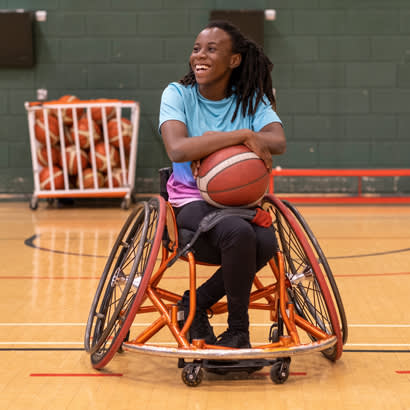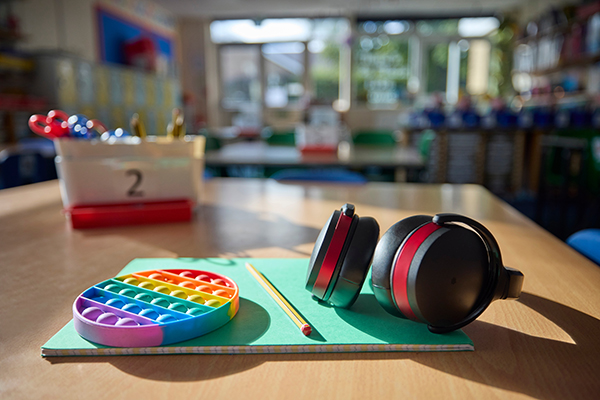
Pictured: Youth play a game of wheelchair basketball. Photo courtesy of Adobe Stock.
This blog post is part three in a series about facilitating inclusion for people with disabilities in parks and recreation. In part one, we provided an overview of inclusion and explored why it matters in parks and recreation. Read part one here. In part two we discussed how to facilitate inclusion at an organizational level by including self-advocates, creating an accessible environment, and implementing organizational and programmatic changes. Read part two here. Today, we will discuss some common supports for facilitating inclusion in parks and recreation.
There are many types of support that organizations can provide to individuals with disabilities to boost inclusion. Common types of support are 1) hiring additional staff/volunteers; 2) social support; 3) behavioral support; 4) environmental support; 5) visual support; and 6) rules accommodations. Below are some examples of different types of support:
Additional Staff/Volunteers
Hiring additional staff or recruiting volunteers to support individuals with disabilities in programming may be needed for assisting with accessibility equipment, or participants with intellectual and developmental disabilities.
Social Support
Social support helps everyone to be included in social activities. For example, for a group program that serves youth, the group leader can arrange pairs or teams instead of asking participants to choose to avoid unintentional exclusion.
Behavioral Support
Behavioral support can be used to prevent behavioral challenges. Some strategies include:
- Pre-teaching skills needed for the program. Pre-teaching means breaking down the skills required into discrete steps and offering one-on-one or group instruction beforehand.
- Using multi-modal instruction. We all learn in different ways. By using multiple ways of teaching (e.g., auditory, visual, tactile), we can make sure everyone has access to learning.
- Checking for learning. After teaching a skill, ask participants to demonstrate the learned skill. If teaching a rule or expectation, ask them to say it back to you, so you can be sure it was understood.
Sensory Support
Sensory support helps to reduce behavioral challenges and offers a safe space for individuals who need a break from the sensory load of a typical program or recreational setting. Individuals can be sensory-seeking or sensory-avoidant, and this can change from day to day for each person. Sensory seekers are looking for opportunities to engage with sensory input, like climbing, running, feeling, looking at pictures or videos, etc. Sensory avoiders look for less input from the environment, like wearing headphones to calm down the noise, turning down the lights or wearing sunglasses to avoid bright lighting, and other ways to calm the senses.

Pictured: Sensory kits can include many items, some examples shown in the photo are headphones, fidget toys, and a paper/pencil for drawing. Photo courtesy of Adobe Stock.
One way to support sensory seekers and avoiders is by creating a sensory kit with headphones, sunglasses, and other calming items for individuals who may be sensory-avoidant. In this kit, you can also include items for sensory seekers such as fidget toys, light toys and other tactile items.
In addition to having sensory kits on hand, consider a space in the environment where you could set up a sensory tent, room or quiet space for individuals who may need a break. You can purchase a kids’ tent to use for this purpose or use an existing space. The space should be able to have the lights turned down and should be quiet and somewhat removed from the busyness of the overall environment.
Environmental Support
This may include choosing an accessible location for the program or event, considering the sensory load of the environment and making any changes (e.g., replacing fluorescent lighting with LED lighting on dimmers).
Visual Support
Visual schedules, token systems and social stories are helpful support tools, especially for programming with youth. Many other types of visual supports can be used to accommodate individuals across the lifespan. One example of how we use visual supports is gender icons on public restroom signs.
Rules accommodations
Sometimes rules prevent equitable participation in an activity. Consider making changes or adaptations to program rules to allow for all to take part.
Now that you have reviewed this list of common supports to facilitate inclusion, take a minute to think about the programs at your agency and consider those that would be most helpful for building a more inclusive setting.
Portions of this content reflect an inclusion curriculum developed at the University of Rochester Strong Center for Developmental Disabilities.
To learn more about how you can support inclusion in parks and recreation, visit NRPA’s Parks for Inclusion resource page.
Jennifer Ward (she/her) is an evaluation manager at NRPA.

